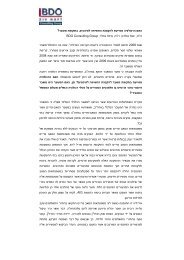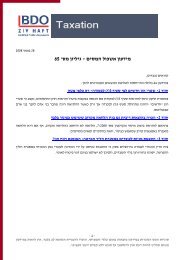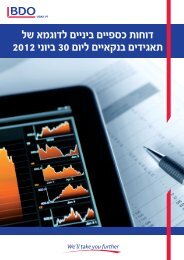preface
preface
preface
Create successful ePaper yourself
Turn your PDF publications into a flip-book with our unique Google optimized e-Paper software.
8<br />
THE ISRAELI ECONOMY IN 2010<br />
The Israeli economy was marked by continuous progress in 2010, with an<br />
annual growth rate of 2.7% GDP per capita. Inflation stood at 2.6% while Bank<br />
of Israel interest rates gradually rose from 1.25% in January 2010 to 2% in<br />
December 2010. Imports and exports recovered in the first half of 2010 but<br />
declined later, in the third quarter. The current account surplus remained stable<br />
at 4.3% of GDP in the second quarter. Furthermore, the Debt-to-GDP ratio<br />
improved in 2009, dropping to 77.7%. Finally, the labor market also underwent<br />
major improvements, with a 6.6% unemployment rate in Q3 and a participation<br />
rate increasing to 57.8%.<br />
Israel was invited to join the OECD as a full member on May 10 th , 2010 and<br />
officially joined on May 27th, 2010. This marked another step in Israel’s ability<br />
to better accomplish necessary reforms and enhance its credit rating and<br />
investment atmosphere, resulting in the development of various sectors of<br />
Israeli society and economy, particularly in the environmental, educational and<br />
employment sectors. The improvement and upgrading process gained by<br />
joining the OECD will persist so long as the Israeli government pursues a<br />
constant peer review and adjusts its regulation policy to the standards<br />
maintained by the other OECD members.<br />
Below is a summary of the main economic indicators in Israel.<br />
This chapter concludes with a forecast of major economic developments based<br />
on several sources including, inter alia, the Bank of Israel's Research<br />
Department, the Ministry of Finance and a number of commercial banks.<br />
1.2. MACRO-ECONOMIC DEVELOPMENTS IN 2010<br />
1.2.1. Gross Domestic Product (GDP)<br />
Israel fell, promptly but briefly, into the recession during the global<br />
financial crisis of 2008 and 2009. It entered the crisis with solid<br />
fundamentals, thanks to years of a cautious fiscal policy, a series of<br />
liberalizing reforms and a flexible banking sector. As a result, the Israeli<br />
economy showed signs of an early recovery.<br />
In 2010, the Israeli GDP increased by 4.5%, compared with 0.8%<br />
growth in 2009 and 4.2% in 2008.<br />
Israel’s population grew by 1.9% in 2010, while the GDP per capita<br />
increased by 2.7%, compared with a 1.1% decrease in 2009. In 2010,<br />
the GDP per capita totaled NIS 106.4 thousand ($28.5 thousand). In<br />
BDO Israel

















